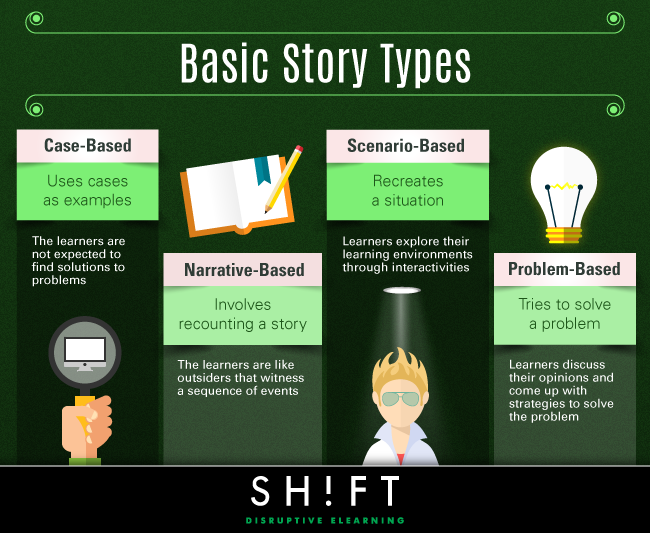Everybody loves a good story, even your (seemingly) staid and somber corporate learners. That's because, a child lurks inside all of us; he loves to peek into other people's lives and go with them on their journeys. Unconsciously, he tries to identify himself with the good guy in the story—the one who overcomes all challenges, bashes the baddies, and emerges as the hero in the end. Stories are captivating. The actions of the protagonist, who we can relate to, inspire us to think or act similarly. This is why, stories have been used throughout the ages to teach morals and values to children. You can also use stories to teach your corporate learners technical and soft skills that will help them further their careers.
There are four basic type of stories. You have to know about them before you can choose a format that best fits the drab learning matter and tell a story that your learners will lap up.

1) Case-Based Instruction
Try advising someone on the ill effects of eating out every other night, and he will turn a deaf ear. Tell him that your friend lost 20 lbs in two weeks and kept the weight away simply by brown-bagging her lunch and cooking her dinner, and you will see a spark of interest in his eyes. Now tell him that your friend saves hundreds of dollars every month by cooking at home, and you will be flooded with questions. This is the power of teaching using cases as examples.
We are social creatures. We are inspired by other people's actions that turn out to be beneficial in some way. So, case-based stories immediately rivet our attention. Case-based instruction is a tried-and-tested teaching method used to impart understanding of a subject; the learner is usually not expected to find solutions to problems. This method is ideal for teaching legal and business principles and for imparting medical knowledge like diagnosing and treating diseases.
But developing case-based instruction is not just about dumping the facts and hoping the learners will take the cues. Here are a few pointers:
- Find out cases from real life and enhance their credibility by using photographs, testimonials, and videos, if any. We are more motivated by the lesson when we know someone authentic has been there, done that, and is now benefitting as a result. Your corporate learners are application-oriented individuals who will see through fairy tales, so don't try spinning any.
- Ensure the case mirrors the reality of the learners, so they know right at the outset what's in it for them and are hooked.
- Ensure the readers can relate to the characters, their life situations, and dilemmas.
- Although in case-based instruction, the learner does not have to resolve problems, you can enhance engagement levels by introducing interactivities sparingly but at strategic points. For instance, you can interrupt the recounting of the case and ask the learners to think through a problem and suggest a remedial action. Then resume narrating the case and reveal the answer to the problem.
2) Narrative-Based Instruction
As is evident from the moniker, narrative-based instruction involves recounting a story. The events in the story may be fictional or factual. Like any story, narration-based courses contain a narrator who may or may not be the protagonist and an antagonist who symbolizes the problem or the challenge that the hero has set out to overcome. Like case-based instruction, the learner in a narration-based course is like an outsider who is being made to witness a sequence of events. But narrative courses seek to create an emotional connection between the learner and the protagonist.
Think of the movies you watch. You are touched by the plight of the wronged boy or girl. You feel inspired by the toils of average Joe who holds fast to his big dreams and strives to realize them. Movies make you laugh out loud or cry helplessly because they tell stories that touch you. Narration-based instruction is no different. Such a course strives to inspire action from you by stirring you emotionally.
Keep the following in mind when creating a narration-based course:
- Create engagement with your narration style, characterization, and the situations you portray. Your audience should be able to relate to the protagonist and empathize with his problems. His challenges should be realistic and relevant for your target audience. Else you cannot create the emotional connection.
- Tell your story, but do not let it distract your audience from the learning activities. For instance, do not make the characters in the story larger than life, else they will hog attention. Make the narrator realistic with an air of respectability around him, but keep him low-key. Flashy clothes, an alien or funny accent, or exaggerated mannerisms distract the learners.
- Create tension within the plot to keep the story engaging and learner interest up till the end. You may or not follow the chronological sequence of events. Or you may introduce assessment tasks or learning activities to break the narration and tickle the learners' gray cells.
3) Scenario-Based Instruction
Scenario-based instruction is a popular learning method in operational industries and for sales training. This method of imparting instruction is radically different from the case- and narration-based methods because it involves active learner participation.
Although scenario-based instruction usually deals with one problem, there can be more than one solution and learners are expected to explore their learning environments through interactivities and come up with the solutions themselves through trial and error. Scenario-based instruction is designed to simulate reality where learners have to face the consequences of their actions. Such courses are "safe" environments where the learner can explore different outcomes with their choices without worrying about the repercussions.
Scenario-based instruction provides numerous opportunities for you to test the learner's understanding and provide him feedback to reflect on his learning and rethink, revise, and refine his performance. These are decision-points where the learner has to apply his knowledge and think analytically.
To create an effective scenario-based instruction, you have to ensure the following:
- A scenario can be factual or fictional. If you create an imaginary scenario, ensure the learner can relate to it and feels motivated to explore the outcomes.
- A course can contain more than one scenario. Not all aspects of a problem may be effectively captured by a single scenario. To prevent a scenario from becoming long-drawn-out and overtly complex, you can use multiple scenarios in a course.
- Think about creating story-based scenarios. This ploy lets your audience connect emotionally to the scenario.
4) Problem-Based Instruction
Remember all the brainstorming sessions you have in your office? Or the dinner-table discussions on where to go during the holidays or how to keep the utility bills in check? They all start with a problem that has no fixed formulaic solution in sight. The problem is usually quite dynamic with many possible outcomes. So how do you go about solving the problem? Everybody puts their heads together, and sometimes voices are raised. There may also be much banging on the table. Eventually, you all manage to come to a consensus because there is usually no one "right" solution to the problem. Problem-based instruction is no different, except the shouting and the table-thumping parts.
Learner participation is the key in problem-based instruction models. This instructional method is used to help learners hone their critical thinking skills by getting them to ponder over a challenging problem that usually has no single formulaic outcome. Often, it deals with problems that may not have a solution or are not likely to take place in reality—the what-if question.
Problem-based instruction is used extensively to teach soft skills and develop cognitive powers. The instruction may take place in a group environment where learners can discuss their opinions and come up with strategies. After delineating the problem, which may be fictional or real, the trainer may or may not steer the discussion towards a resolution or consensus.
The stories that touch the heart survive through the ages. We read fairy tales, and now we tell these stories to our kids. We love to watch some movies over and over again. We are never tired of the re-runs of our favorite television shows. Weave a story to give such enduring value to your course.
Here you go! Four different story formats you can use to lighten-up your content.
A story is a fact wrapped in an emotion that can compel us to take action and so transform the world around us.- Robert Dickman 2003
Sources:
Storytelling as an Instructional Method: Definitions and Research Questions








